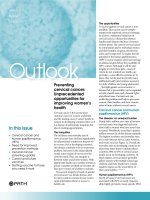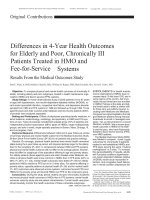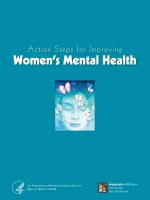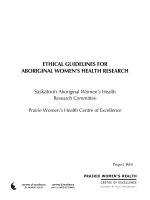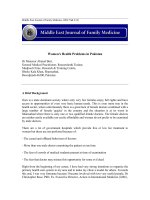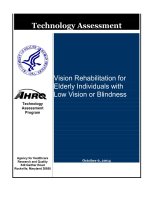Health for Elderly Women pot
Bạn đang xem bản rút gọn của tài liệu. Xem và tải ngay bản đầy đủ của tài liệu tại đây (57.21 KB, 6 trang )
1
Health for Elderly Women
Dr Arvind Dubey
Elderly women are as those who have crossed a given life span, 65 years in developed countries
and 60 years in developing countries like India.
Aging theory
No one really knows how and why people change as they get older. Some theories claim that aging
is caused by accumulated lifelong influences and/or injuries from ultraviolet light, wear and tear on
the body, by-products of metabolism, and so on. Other theories view aging as a predetermined,
genetically-controlled process.
Body changes with age
Changes in body shape
Fat tissue may increase toward the centre of the body, including around the abdominal organs. The
loss of muscle mass in the legs and changes in body shape can affect her balance, leading to falls.
A woman may appear shorter as she ages. This height loss is related to aging changes in the bones,
muscles, and joints. Women typically lose about 1 cm (0.4 inches) every 10 years after age 40.
Height loss is even greater after 70 years old. In total, she may lose 1 to 3 inches in height in rest of
her life. Women usually gain weight until age 65, and then begin to lose weight. Physical activity, a
proper diet, and treating osteoporosis can help reduce these changes.
Hearing loss
Age-related hearing loss or presbycusis is mainly caused by changes in the inner ear. However,
your genes and loud noises (such as from rock concerts or music headphones) may play a large role.
Initially there is difficulty in hearing high-frequency sounds, such as someone talking. As hearing
gets worse, it may become difficult to hear sounds at lower pitches. Hearing aids Telephone
amplifiers and other assistive devices may be helpful. A cochlear implant (Surgery) may be
recommended for certain women with very severe hearing loss. The implant makes sounds seem
louder, but does not restore normal hearing.
Changes in the bones, muscles and joints
The bones lose calcium and other minerals especially in women after menopause. The trunk
becomes shorter as the gel-like cushions or intervertebral disks, between each spine bone
(vertebrae) gradually lose fluid and become thinner along with gradual loss of mineral content of
vertebrae itself, making each vertebra thinner. As a result, the spinal column becomes curved and
compressed (packed together). The foot arches become less pronounced, contributing to a slight
loss of height. The arms and legs look longer when compared with the shortened trunk. Bones
become more brittle and may break more easily. The joints become stiffer and less flexible. Almost
all elderly women are affected by joint changes, ranging from minor stiffness to severe arthritis.
After 40 the muscle fibbers shrink and replaced slowly with a tough fibrous tissue.Muscle changes
often begin in the 40s in women. Lipofuscin (an age-related pigment) and fat are deposited in
muscle tissue. This is most noticeable in the hands, which may appear thin and bony. Muscles may
become rigid with age and may lose tone, even with regular exercise. Loss of muscle mass reduces
strength which contributes to fatigue, weakness, and reduced activity tolerance. Exercise is one of
the best ways to slow or prevent problems with the muscles, joints, and bones.
2
The posture may become more stooped (bent) and the knees and hips more flexed. The neck may
become tilted, and the shoulders may narrow while the pelvis becomes wider. Movements become
slower and may become limited. Walking may become unsteady, and there is less arm swinging.
The risk of injury increases because gait changes, instability, and loss of balance may lead to falls.
Osteoporosis
Osteoporosis a common problem in older women, is a disease with low bone mineral density
(BMD) and poor bone quality, resulting in reduced bone strength and increased risk of fracture. A
well-balanced diet with adequate amounts of calcium is important. Postmenopausal women need
1,200 - 1,500 mg of calcium and 400 - 800 international units of vitamin D per day.
Changes in skin
Evidence of increasing age includes wrinkles and sagging skin. Aging skin appears thinner, more
pale, and clear (translucent). Thus, skin is at higher risk for injury. Large pigmented spots (called
age spots, liver spots, or lentigos) may appear in sun-exposed areas. The blood vessels of the skin
become more fragile. This leads to bruising, bleeding under the skin. Women’s skin gradually
produces less oil beginning after menopause. This can make it harder to keep the skin moist,
resulting in dryness and itchiness. The sweat glands produce less sweat. This makes it harder to
keep cool, and they are at increased risk for becoming overheated or developing heat stroke. Use of
a good quality sunscreen when outdoors (even in the winter), wearing protective clothing, good
nutrition and adequate fluids, keeping skin moist with moisturizers, avoiding use of heavily
perfumed soaps can keep the skin moist and healthy.
Changes in the hair
Graying of the hair often begins in the 30s, although this varies widely. Hair becomes progressively
lighter, eventually turning white. Elderly women may develop a typical pattern of hair loss
(female-pattern baldness). The hair becomes less dense all over and the scalp may become visible.
Some women may find coarse facial hair, especially on the chin and around the lips.
Changes in nails
The nails may become dull and brittle. They may become yellowed and opaque. Nails, especially
toenails, may become hard and thick. Ingrown toenails may be more common. Sometimes,
lengthwise ridges will develop in the fingernails and toenails.
Changes in the face
Due to decreasing muscle tone the jowls may begin to sag, leading to a "double chin". Nose may
lengthens slightly and may look more prominent. The ears may lengthen slightly in some women.
The eyebrows and eyelashes become gray. The skin around the eyelids becomes loose and
wrinkled, often making a "crow's feet" pattern. The eye socket loses some of its fat pads, making
the eyes look sunken and limiting eye movement. The lower eyelids may appear baggy, and
drooping eyelids are fairly common. The outer surface of the eye (cornea) may develop a grayish-
white ring called arcus corneus or arcus senilis.
Loss of teeth can make the lips look shrunken. The jawbone loses bone material, reducing the size
of the lower face. The forehead, nose, and mouth thus look more pronounced. Gums may also
recede, contributing to dental problems and changes in the appearance of the mouth.
3
Changes in the breast
Breasts lose tissue and subcutaneous fat, reducing breast size and fullness. Most of the mammary
glands are replaced by fat tissue so make the breast less firm. Nipple may turn in slightly. The area
surrounding the nipple (the areola) becomes smaller and may nearly disappear. Lumps are common
around the time of menopause. Breast cancer risk increases with age. Women should perform
monthly breast self-examinations and should also talk to their health care provider about
mammograms (Breast scans).
Changes in the Vision
Aging eyes produce fewer tears. The cornea becomes less sensitive, so injuries may not be noticed.
By the time someone turn 60, her pupils decrease to about one-third of the size they were when
they were 20. The lens becomes yellowed, less flexible, and slightly cloudy. The eye muscles
become less able to fully rotate the eye.
Sharpness of vision (visual acuity) gradually declines and eventually bifocals are need. One may be
less able to tolerate glare, and may have more trouble adapting to darkness or bright light.
The fluid inside eye may change. Small particles can create "floaters" in the vision not a dangerous
condition. However if someone suddenly develop floaters or have a rapid increase in the number of
them, she should have checked her eyes by a professional.
Common eye disorders in the elderly include cataracts (progressive opacification and hardening of
the lens of the eye, glaucoma (increased pressure in the eye, if left untreated may lead to blindness)
senile macular degeneration (destruction of the point of maximum visual acuity on retina), and
diabetic and hypertensive retinopathy (changes in retina due to diabetes and hypertension).
Changes in the taste and smell
After the age of 40 to 50 in women number of taste buds decreases and remaining taste bud begins
to atrophy (lose mass) but the sensitivity to the four taste sensations does not seem to decrease until
after age 60. Additionally mouth produces less saliva with advancing age. This causes dry mouth,
which can make swallowing more difficult. The sense of smell may diminish, especially after age
70.
Changes in touch, vibration, and pain
After the age of 50, many women have reduced sensitivity to pain and touch-related sensations.
While walking, due to reduced ability to perceive where their bodies in relation to the floor, risk of
fall increases.
Changes in the nervous system
Brain and spinal cord lose nerve cells and weight. Nerve cells may begin to transmit messages
more slowly. A fatty brown pigment (lipofuscin) can also build up in nerve tissue. Slight slowing
of thought, memory, and thinking may occur. Both physical and mental exercise can help maintain
thinking abilities.
Changes in sleep
4
Besides difficulty in falling asleep there may be average three or four awakenings each night, but
total sleep time remains the same (6.5 to 7 hours per night). However they may feel deprived of
sleep because they sleep more lightly, wake up more often and are more aware of being awake.
Sleep apnoea, where the breathing stops for a time during sleep, can cause severe problems.
Measures to promote sleep may be-
• A glass of warm milk at bedtime contains a natural, sedative-like amino acid).
• Avoiding stimulants like caffeine (found in coffee, tea, cola drinks, and chocolate) for at
least 3 or 4 hours before bed.
• Do not take naps during the day.
• Moderate exercise in the afternoon.
• Go to bed at the same time every night and wake at the same time each morning.
• Use the bed only for sleep.
• If you can't fall asleep after 20 minutes, get out of bed and do a quiet activity, such as
reading or listening to music and when you feel sleepy, get back in bed and try again. If you
still can't fall asleep in 20 minutes, repeat the process.
Changes in the female reproductive system
The ovaries stop releasing eggs (ova), and menstrual periods stop (Menopause). Most women
experience menopause around age of 45 to 50. Prior to menopause, menstrual cycles often become
irregular.
The vaginal walls become less elastic, thinner, and less rigid. The vagina becomes shorter.
Secretions become scant and watery. The external genital tissue decreases and thins (atrophy of the
labia). A woman may experience changes in her sex drive (libido) and her sexual response may
change, but aging does not prevent a woman from being able to have or enjoy sexual relationships.
The pubic muscles lose tone, and the vagina, uterus, or urinary bladder can fall out of position. This
is called vaginal prolapse, bladder prolapse, or uterine prolapse. A prolapse of any of these
structures increases the risk of problems such as stress incontinence (urine leakage). Most
prolapses can be treated.
Irritation of the external genitals can occur (pruritus vulvae). As vaginal walls become thinner and
dryer and sexual intercourse may become uncomfortable for some women (dyspareunia). Similar
changes to the bladder and urethra may increase symptoms such as frequency and urgency of
urination, and there is an increased risk of urinary tract infection. Hot flashes, mood disturbances,
headaches, and sleep disturbances are also common symptoms during menopause.
Adequate lubrication (with a water-soluble lubricant) can help prevent painful sexual intercourse.
Oestrogen replacement can prevent or reduce many of the symptoms associated with menopause
but consult your doctor before taking it.
Changes in the heart and blood vessels
An aging heart may be slightly less able to tolerate increased workloads, because changes reduce
this extra pumping ability (reserve heart function). Abnormal rhythms (arrhythmias) are common.
The main artery from the heart (aorta) becomes thicker, stiffer, and less flexible. This makes the
blood pressure higher and makes the heart work harder, which may lead to thickening of the heart
muscle (hypertrophy). Transient ischemic attacks or strokes can occur if blood flow to the brain is
disrupted. Coronary artery disease is fairly common. Angina (chest pain caused by temporarily
5
reduced blood flow to the heart muscle), shortness of breath with exertion, and heart attack can
result from coronary artery disease.
Eat a heart-healthy diet with reduced amounts of saturated fat and cholesterol, control your weight
and stop smoking. Moderate exercise is one of the best things you can do to keep your heart, and
the rest of your body, healthy. Have regular check-ups for your heart.
Changes in the lungs
The maximum lung function decreases with age. The amount of oxygen diffusing from the air sacs
into the blood decreases. The voice box (larynx) also changes with aging. This causes the pitch,
loudness, and quality of the voice to change. The voice may become quieter and slightly hoarse.
The pitch may be decreased (becoming lower) in women.
Decreased ability to exercise, abnormal breathing patterns including sleep apnoea (episodes of
stopped breathing during sleep), increased risk of lung infections such as pneumonia, bronchitis or
cancer are common in the elderly women. Exercise and good overall fitness improve breathing
capacity.
Changes in the kidneys and urinary bladder
Kidney function may be slightly reduced with aging. The number of filtering units (nephrons)
decreases. Nephrons filter waste material from the blood. The blood vessels supplying the kidney
can become hardened, and the kidneys filter blood more slowly.
The urinary bladder wall elastic tissue becomes tough, and the bladder becomes less stretchy. Its
Muscles weaken, and the bladder may not empty completely when urinating. In women, weakened
muscles can allow the bladder to fall out of position (prolapse), which can block the urethra. All
this increases the risk for kidney failure, Urinary incontinence (leakage of urine) and Bladder
infections
Diseases prevalent in elderly women
Common diseases in elderly women are Arthritis, Cancer, Hypertension and Heart Diseases,
Strokes, Dementia (serious loss of thinking ability), Depression, Diabetes, Falls and Injuries, Gut
Disorders, Hearing impairment, Memory loss, Malnutrition, Osteoporosis, Parkinson's Disease,
Respiratory Diseases, Pressure ulcers, Sleep problems, Thyroid Disease, Urinary Disorders Visual
impairment etc.
Top ten leading causes of death for elderly women
1. Heart diseases-Older women have the highest rates of heart attack due to their higher rates
of high blood pressure, high cholesterol, diabetes, obesity, and physical inactivity The most
common cause of heart disease is narrowing or blockage of the coronary arteries, the blood
vessels that supply blood to the heart itself. This is called coronary artery disease and
happens slowly over time. It's the major reason in older women for heart attacks.
2. Cancers- Old age is called age of cancers. Breast Cancer, Cervical Cancer (Cancer of the
mouth of uterus), Colon & Rectum Cancer, Endometrial (Uterine) Cancer, Lung Cancer,
Ovarian Cancer, Skin Cancer are common cancers in elderly women. So for any abnormal
growth or non healing ulcer consult the doctor immediately.
6
3. Stroke-Transient ischemic attacks or a stroke is “rapidly developing loss of brain function(s)
due to disturbance in the blood supply”. Female hormones (Oestrogen) protect women in
their younger years, and when they became post-menopausal that protection is lost and an
increased risk of stroke may occur. The chance of having a stroke more than doubles for
each decade of a woman's life after age of 55.
4. Chronic obstructive pulmonary diseases (COPD)-commonly co-existing diseases of the
lungs in which the airways become narrowed. This leads to a limitation of the flow of air to
and from the lungs causing shortness of breath. In contrast to asthma, this limitation is
poorly reversible and usually gets progressively worse over time.
5. Pneumonia
6. Influenza
7. Diabetes-Elderly women with diabetes are particularly at risk for cardiovascular disease,
visual problems, and hypothermia and may also be at greater risk for metabolic disorders,
cognitive dysfunction, and depression.
8. Injuries-Falls account for 87% of all fractures for elderly women and out of these most are
hip fractures. About one-fifth of hip fracture patients require long-term nursing home care,
and 10% remain functionally dependent for daily living care.
9. Kidney diseases
10. Atherosclerosis- It is a condition in which an artery wall thickens as the result of a build-up
of fatty materials such as cholesterol. For many elderly women, the first symptom of
atherosclerotic cardiovascular disease is heart attack or sudden cardiac death (death within
one hour of onset of the symptom).
Tips for Aging Well
It’s never too late to make changes that can help you live a longer and healthier life. Tips for living
longer and better are-
1. Choose nutrient rich foods. Limit red meat and whole-fat dairy products. Choose whole
grains over the refined stuff.
2. Walk for 30 minutes, at least three times a week.
3. Strengthen your bones and lower your risk of falls. Get plenty of calcium and vitamin D
daily. Bicycling, dancing, and jogging are also good weight-bearing exercises that can help
strengthen your bones.
4. Playing complex computer games, joining a discussion club, learning a new language, and
engaging in social give-and-take with other people can all help keep your brain sharp.
5. Pay regular visits to your doctor. If you have multiple, chronic health problems, your best
bet may be to see a geriatrician – a physician with advanced training for care of elderly.
6. When you visit your healthcare professional, bring either all of the prescription and over-
the counter medications, vitamins, herbs and supplements you take, or a complete list that
notes the names of each, the doses you take, and how often you take them. He or she should
make sure they’re safe for you to take.
7. Get the vaccines for pneumonia, flu, hepatitis and others diseases like tetanus/diphtheria,
shingles etc.
8. Speak up when you feel down or anxious.
☯☯☯
